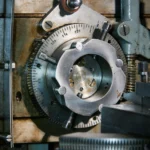
In the heart of Los Angeles, Michael Rose, a skilled watchmaker at J.N. Shapiro, meticulously inspects a pinion—a delicate gear with tips as thin as a human hair—on his computer screen. Amidst his workspace sits a skateboard, an unusual sight for a professional setting. However, Rose doesn’t use it for skateboarding; instead, it serves as a convenient mode of transportation within J.N. Shapiro’s expansive 7,300-square-foot office, navigating from the Ping-Pong table at the back to the vintage engine turning machines at the front.

The Journey of J.N. Shapiro
Josh Shapiro, the 38-year-old founder of J.N. Shapiro, embarked on his horological journey in 2018. Starting with humble beginnings, Shapiro initially tinkered with watches in his kitchen nook, arranging his collection of watchmaking machines around his dining table. Over time, his passion evolved into a full-fledged brand, culminating in the establishment of J.N. Shapiro. After several relocations, including a rundown house and a small studio, the brand found its home in a state-of-the-art facility in August, signaling a significant leap forward for America’s dormant watchmaking tradition.
The Resurgence of American-Made Watches
In May 2023, J.N. Shapiro unveiled its latest creation, the Resurgence, priced at $85,000 in gold and $70,000 in steel. What sets this timepiece apart is its claim to being entirely made in America—an unprecedented feat in over five decades. Joshua Shapiro boldly asserts the Resurgence as a beacon of hope for the domestic watch industry, bearing the weight of half a century of lost opportunity. This groundbreaking achievement marks a potential turning point, reminiscent of the resurgence catalyzed by George Daniels in the UK.

The Legacy of American Watchmaking
During the 1850s, Aaron Dennison, the founder of Waltham Watch Company, revolutionized the watch industry with the American system of watchmaking. By standardizing components, Dennison’s innovation vastly improved efficiency, propelling American watchmakers to the forefront of the global market. Brands like Hamilton, Bulova, Waltham, and Elgin flourished, producing affordable and reliable timepieces that rivaled their Swiss counterparts.
Challenges and Innovations
World War II dealt a significant blow to the American watch industry, as manufacturers shifted focus to wartime production. Meanwhile, neutral Switzerland continued watchmaking unabated, gradually seizing control of the global market. The decline culminated in the closure of Hamilton’s American factory in 1971, marking the end of an era. However, enthusiasts like Shapiro endeavor to revive this lost art, overcoming challenges such as stringent regulations and the scarcity of US-based part suppliers.

Embracing Tradition and Innovation
At J.N. Shapiro’s facility, antique machines coexist with state-of-the-art technology, symbolizing a blend of tradition and innovation. Engine turning machines dating back to the early 1900s stand alongside modern CNC machines, which produce intricate watch components with unparalleled precision. Despite the complexity of manufacturing, Shapiro remains steadfast in his commitment to American craftsmanship, echoing sentiments shared by fellow watchmakers like Roland Murphy of RGM.

Crafting the Future of American Horology
J.N. Shapiro’s journey mirrors the rich legacy of American watchmaking, paying homage to the pioneers who paved the way. With the Resurgence, Shapiro not only offers a timepiece but also a testament to the resilience of American craftsmanship. As orders for the Resurgence continue to pour in, Shapiro looks ahead, poised to redefine the narrative of American horology. In a world dominated by Swiss giants, J.N. Shapiro stands as a beacon of hope, igniting a resurgence of America’s great watchmaking tradition.


















Leave a Reply